Customer Support Outsourcing: A Complete Guide To Meeting Modern Customer Demands


It’s no secret that modern customers simply won’t accept bad quality support. In fact, an incredible 17% of customers will churn after just one bad experience with your brand according to PWC.
But challenger businesses also need to ensure the cost of meeting those support expectations doesn’t become an obstacle to growth.
All of this means how a customer support outsourcer approaches things like agent hiring, ongoing performance management, and staffing models (amongst other things) is going to go a long way to determining your success.
To help you understand all the elements that go into making an effective outsourced customer support program – we’re using this page to dig down into the details on: the benefits, key definitions, metrics, and how to orchestrate the right strategy (amongst other things).
This foundational knowledge is vitally important if you want a customer support program (outsourced or not) that can meet modern customer demands as well as the demands of your business.
The kind of program that is able to deliver high-quality with costs that diminish over time (spoiler, we already did it).

Let’s get to it…
Customer support is the process of dealing with acute customer issues that arise from using a product or service.
This could include troubleshooting of technical issues, implementation queries, or feature explainers.
While it’s important to define customer support in foundational terms to ensure you’re not taking anything for granted, the answer to “what is customer support?” in today’s business context requires us to dig deeper.
Not long ago the definition of customer support outsourcing pretty much meant enlisting the services of an off-shore call center.
But the game has changed...
86% of agents say customer expectations are higher than they used to be and 57% of today’s customers prefer to engage companies through digital customer service channels according to research from Salesforce.
"Today, the answer to “what is customer support outsourcing?” is that it’s a holistic and multichannel approach. Staffed by tech-enabled experts offering efficient resolution, it's allowing customers to engage where and how they want, and combining it with technology and data to deliver support experiences that drive brand loyalty and retention."
-Steve Henry, SVP Client Services, ModSquad
The extensive list of channels that customer support covers could be email support, chatbots, live chat, social media interactions, or messaging through platforms like WhatsApp, as well as more traditional telephone contact center support agents.
Customer support is important because it involves helping customers overcome issues so they can get the most value from your product or service.
This can help drive key metrics like customer sentiment, customer satisfaction scores (CSAT), and Net promoter scores (NPS). These scores are also correlated with customer retention and word of mouth recommendations – two key KPIs.
“Why is customer support important?” requires a more nuanced answer than the key definition above – if we want to talk in terms of modern customers and challenger businesses.
“Our experience is that customers today don’t just want support, they want support on their terms. That means access to genuine experts, consistency across channels, and access to self-service – oh, and they want all of it with minimal wait times,” according to Henry.
Take a look at subscription-based or SaaS models as an example. These working models have caused the importance of customer support to grow exponentially. That’s because in these models it takes to recoup the cost of acquiring a customer (you CAC payback).
Since customer support has become a crucial part of driving customer retention, getting it right (either in-house or with an outsourcing partner) increases the chances of your customer relationships being profitable. In fact, According to Salesforce 86% of consumers say experience is as important as customers and services.
Key benefits of customer support that delivers quality are:
When used correctly, the cumulative benefit of customer support is that it can increase sales revenue by creating more satisfied customers, who stay with your business longer, and buy more of your products.
The overall customer outsourcing benefits are:
Note: In order to access these customer outsourcing benefits you need to find a customer support outsourcing company that shares your goals – and has the expertise to deliver on them.
For example, if your outsourcing partner helps you handle increased calling volumes but provides you with inexperienced staff (the just-clocking-my-hours kind) to achieve that, it will negatively impact your customer satisfaction. This means it will become a drawback rather than a benefit.

92%
Spotify's CSAT score with their outsourcer (us!)
If you want to improve customer support, the key is getting closer to your customers to understand their needs in more detail so you can cater to them.
How you go about doing that depends on whether your customer support program is being run internally or with an outsourcing partner.
We explore both in detail…
To improve customer support in an ‘in-house’ program the first step is gathering customer feedback and using metrics to assess your performance.
Combined, these will give you a benchmark of what’s working and what isn’t and identify the specific needs you’re not meeting.
From there you can assess whether the issue is related to capacity or quality.
The remedy for a capacity issue is typically to increase hiring, drive process improvement or reach out to an outsourcing partner.
When it comes to a quality problem, the solution is often to increase staff training and improve hiring processes. But it can also include improved data-mobility and centralization so agents have access to the info they need to provide better service – and greater staff empowerment to improve motivation.
The best way to improve customer support with an outsourcer is find a partner that:
One way to improve customer support is to use an outsourcing partner that starts by mapping the outcomes that you want. For example, what KPIs are you looking to achieve (CSAT, FCR, ART) rather than simply focusing on the number of agents for coverage.
An outsourcing partner that prioritizes quality over quantity will also help improve your customer support program. When choosing an outsourcing provider, look at their approach to hiring, orientation, and onboarding. For example, at ModSquad the ‘Mods’ we hire are already customer support experts and pick the accounts they work on. This improves product-to-staff fit, staff motivation, and service quality.
To match the outcome-first and quality-centric approach, finding an outsourcing provider that allows you to escape the FTE model will drive further customer support improvement. In these hourly models you’re able to access more quality agents during the times to ensure quality service but scale that down during off-peak hours to ensure cost effectiveness.
To ensure well-trained agents can maximize their impact, choose an outsourcing partner that uses intelligent automation with AI and other tools rather than using AI for its own sake.
That’s the key to ensuring your agents actually have the kind of AI assistance, data access, and digital tools they need to do their jobs most effectively.
It’s also important to consider the outsourcers' approach to AI beyond these frontline applications. For example, are they feeding AI models with historical and real-time data to maximize staffing efficiency? Are they using AI to automatically review and score customer interactions? Are they using that scoring data to drive QA and continuous improvement?
If you’re running a program using an in-house team, assessing the true cost of customer support requires you to consider all the associated employee costs. This includes hiring, onboarding, and continuously tracking staff performance.
As well as the costs associated with efficiency and quality of your teams. For example, cost wastage from under utilization of staff, or customer churn driven by poor support quality.
To help you assess your customer support costs, you will need to use the right customer support performance metrics – these are outlined below…
Customer support outsourcing costs can be a whole lot lower than running an in-house program as you will not have to pay for hiring costs or for providing teams with the premises and technology they need to actually do their jobs.
But it’s not always that simple.
When assessing your customer support outsourcing costs you also need to get to grips with how the cost relates to the outcomes you’re actively looking to achieve.
“There are plenty of outsourcers that on the face of it seem like they’re the cheapest option…but they also tend to be the lowest in quality which will make the true cost a lot higher.”
That’s because low quality in customer service is more likely to make customers churn before you hit CAC-payback, or lead to NPS and CSAT scores that wreak havoc with your bottom line.
All of which will mean the real cost to your business is much higher than the monthly rate you pay the outsourcer. The added issue here is that the outsourcing package that offers you the lowest hourly rate doesn’t always end up being the lowest total cost of ownership.
Customer support quality is such a deal breaker because the costs of acquiring a new customer are much higher than retaining a current one. Prioritizing quality will help you ensure your customer support outsourcing costs don’t become a problem.
The good news? We’ve already cracked this problem – get all the details on overcoming the cost / quality conundrum here.
The main types of customer support or more accurately ‘support-related activities’ are: customer experience, customer service, customer success, and technical support.
Below we explore how customer support relates to each of these including key differences and crossover points.
The distinction between customer experience vs customer support is that customer experience is a much broader term encompassing all the interactions a customer has with your business at any part of their journey. It covers everything from the very first moment they come into contact with your brand through marketing.
Customer experience also includes services such as content moderation, trust and safety services, as well as community management.
Customer support on the other hand, focuses only on solving inbound customer issues, typically after the point of sale. In this way, customer support is a subcategory of customer experience.
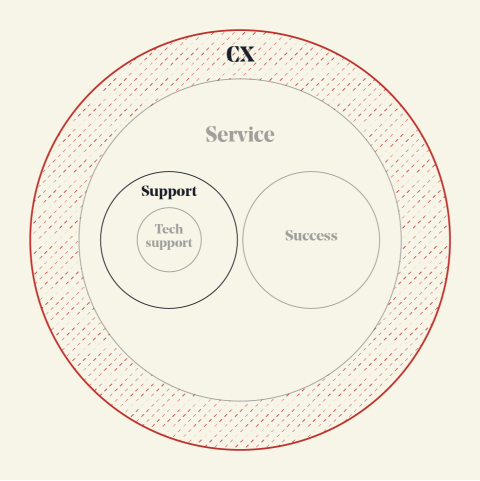
The difference between customer service and customer support is that customer service covers a whole series of activities related to meeting customer needs. Whereas customer support covers a narrower range of activities that are focused around solving customer problems related to using a product or service.
For example, let’s say your business ran a promotion that gave all customers access to premium features for a limited trial period. Customer service would handle any inquiries about eligibility, trial details, and how it could impact billing cycles. Customer support would handle any issues related to actually using the features within the trial.
In this way, comparing customer support vs customer service it can be easier to think of customer support as a subset of customer service.
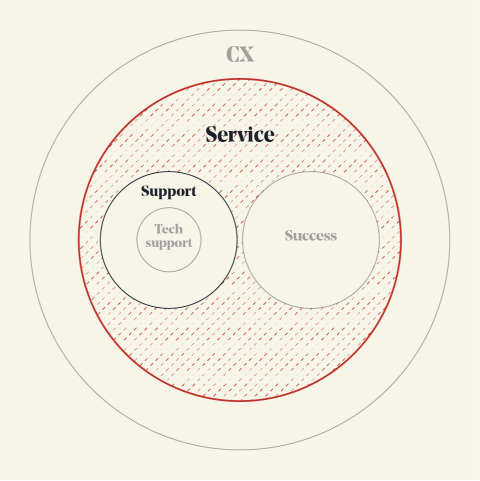
Both customer success and customer support are designed to increase key metrics such as customer sentiment, customer satisfaction, Net Promoter Score, and customer loyalty.
The key difference between customer success vs customer support is that customer success focuses on proactively ensuring customers are getting the most from your products or services. Whereas customer support is focused on ‘reactively’ solving inbound queries and issues.
Examples of customer success (vs. customer support) would be a preemptive to a customer that’s not using all the product features they're paying for to help them either make use of those features, or find a cheaper package that excludes them. Customer support would be if the customer had tried to use the features, failed, and then called into a help center for assistance.
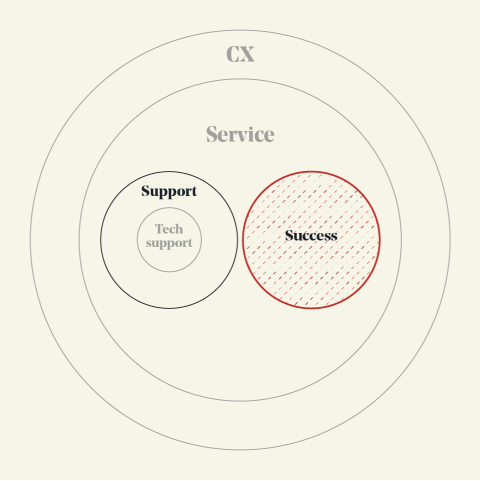
The key difference between customer support and technical support is that technical support is more focused on solving customer queries about the technical side of using your product or service such as hardware, software, networking, or technical implementation issues.
Customer support is a broader term which might additionally include issues related to the purchase, or billing of your product, or using features within the product.
Many regard technical support to be a subgroup of customer support.

Customer support models typically refer to the overall framework in which customer support is delivered.
Customer support tiers on the other hand are different levels of customer support, graded by complexity or expertise. There are typically five tiers from 0, 1, 2, 3, and 4.
Tier 0 – Zero-touch and self-service: Self-education materials such as product explainers, FAQ pages. Includes anything that doesn’t involve direct involvement from your support team.
Tier 1 – Basic enquiry handling: Product updates, release dates, account information requests, simple product feature questions. Support teams are used but tasks are low complexity.
Tier 2 – Troubleshooting: Technical support inquiries, in-depth feature walkthroughs, etc. Support team members with deep product knowledge needed.
Tier 3 – Complex enquiry handling: Major product maintenance issues, prolonged downtime, cyber security issues, complex contractual and billing issues. Problem resolution from expert support teams.
Tier 4 – Third party: Complex technical issues – this is support provided by trusted third-party partners of your business.
Note: Third-parties such as customer support outsourcers are not only confined to Tier 4 as many offer services that cover all tiers.
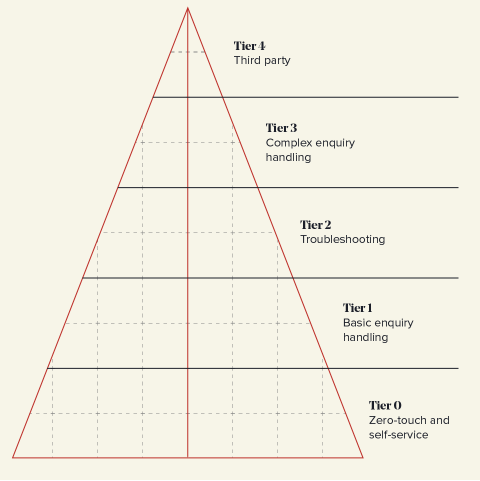
If your business is grappling with how to scale customer support there are there four main ways to approach it: through strategy, using AI, using customer support automation, or by choosing a customer support outsourcing partner.
Setting the right customer support strategy is key when assessing how to scale customer support. The right strategy will include:

Customer support automation can help you scale your customer support program by handling tasks that would otherwise slow your human teams down. This can include zero-touch/self-service elements like automatic password resets, answering simple questions via a chatbot, or by automatically routing an inbound call to the right department.
By removing these tedious manual tasks from human workers, automation helps businesses create more efficient workflows and reduce costs. All of which helps them handle more customer queries per hour which improves scalability.
However, the examples we’ve covered above are just the basics…
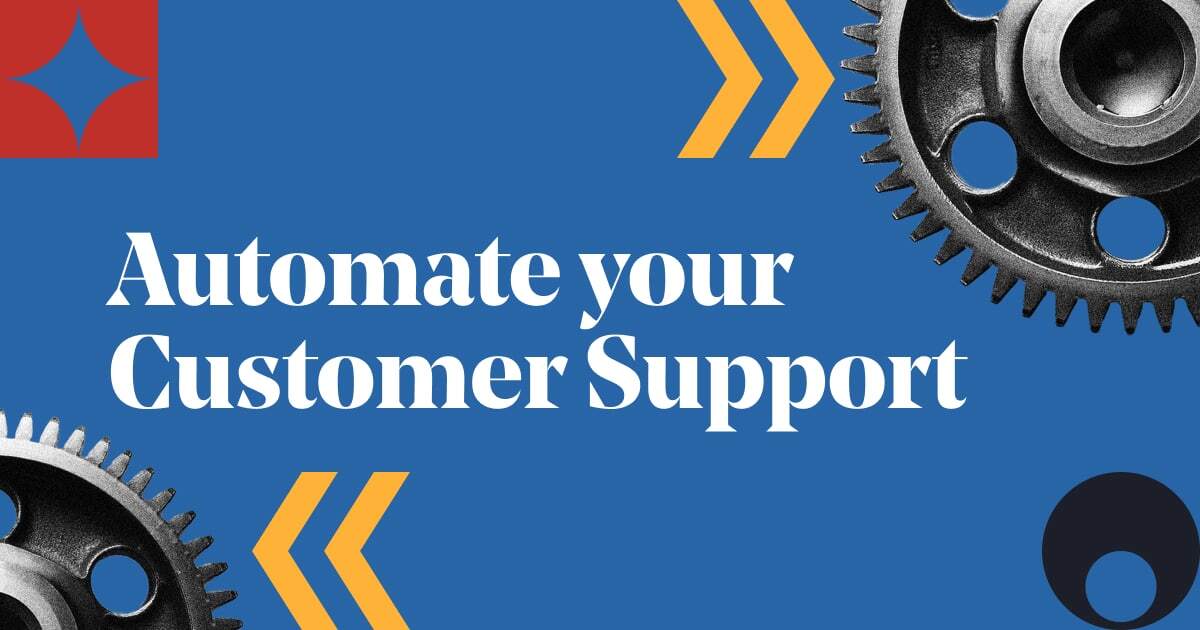
The terms ‘customer support models’ and ‘customer support tiers’ are often used interchangeably – which is pretty unhelpful given there’s a clear difference between them.
Customer support models refer to the overall framework used to deliver customer support. There are three kinds you need to be aware of: collaborative customer support models, automated customer support models, and SaaS customer support models.
Customer support tiers on the other hand are different levels of customer support, graded by complexity or expertise. There are typically five tiers from 0, 1, 2, 3, and 4.
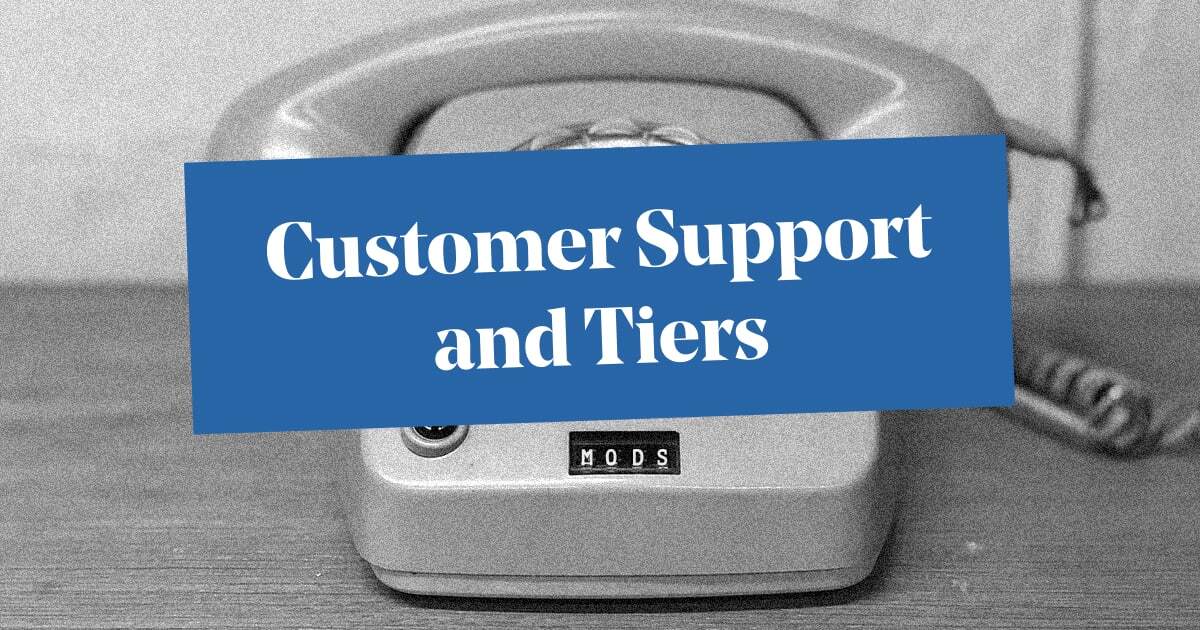
Customer support performance metrics allow you to assess, evaluate, and benchmark the performance of your customer support program – which makes them kinda a big deal.
Chances are you will have heard of the top customer support metrics, they’re things like: Net Promoter Score, Customer satisfaction score (CSAT), and customer effort score (CES).
But before you rush ahead and start tracking these metrics across your customer support program – be warned. To be effective, customer support metrics need to be used as part of a cohesive plan – one that ensures you can actually use data you gather to drive performance improvement.

If your SaaS customer support teams deliver bad experiences, customers aren’t going to jump at the chance of continuing to subscribe from your business – in fact, they might not even stay long enough for you to recoup the cost of acquiring them.
The importance of your SaaS customer support experience becomes even more true if you sell your SaaS product to other businesses. Such SaaS products often involve complex issue resolution, closer relationships with customers, and seamless integration with customer success.
Simply put, it’s hard to overestimate the importance of nailing your SaaS customer support strategy.
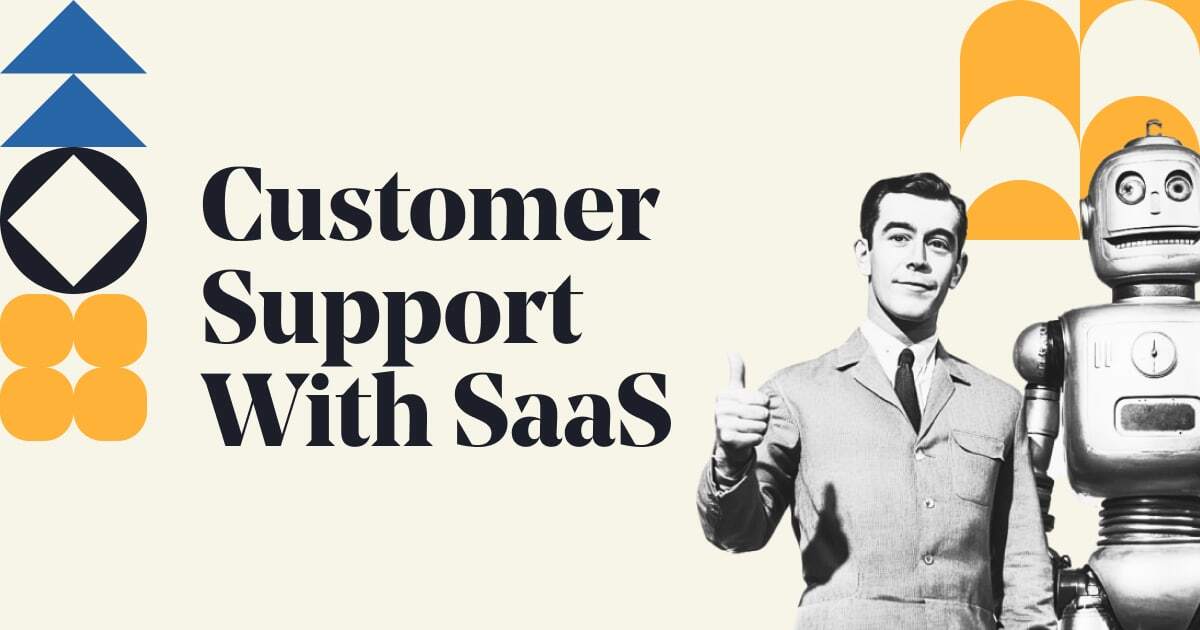
Why is continuously improving customer support so important these days? Because customers have come to expect the stuff they pay for to get better over time. It’s why iterative product development has become table stakes.
And you need to take the same approach with your customer support.
But if you think the answer is just to invest heavily in training – be warned, it ain’t that simple.
At ModSquad we've built our fair share of customer support programs and helped businesses achieve some pretty tasty results in the process.
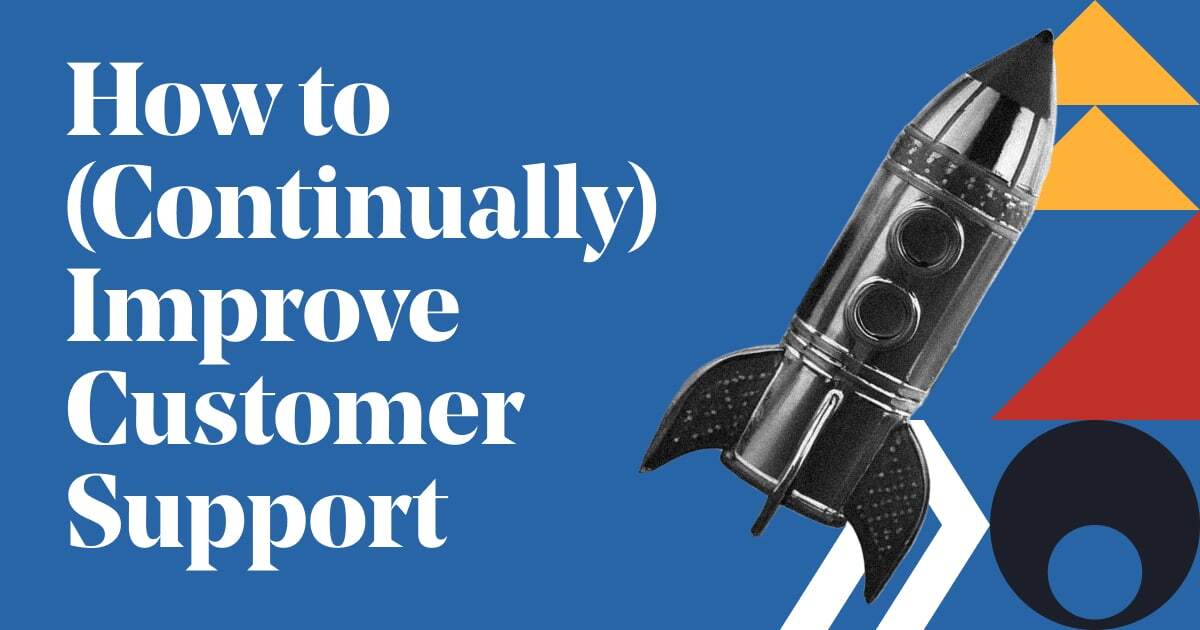
Why is the true cost of customer support such a big deal? Because when you can calculate it accurately, it’s a surefire way to keep both your customers and your CFO happy.
You already know that customer experience (CX) makes or breaks brand loyalty. And you know that the quality of your customer support has a huge impact on CX.
So it should be simple right? Throw money at the problem and things will work out...except that's not how it works in the wild.
At ModSquad, we know you need to look at things a little differently, and that the true cost of customer support is a gnarlier calculation than it seems at first glance.

Perhaps the most impactful way to scale your customer support program is to find an outsourcing partner who can handle it for you.
A good outsourcer will be able to help you with your approach to AI and automation, multichannel support, multilingual support, and performance management all of which will make your customer support program more scalable.
BUT – there’s the big caveat: there are outsourcers and there are outsourcers. Many will provide you with outsourced agents that increase capacity at the expense of quality.
Some will even lock you into rigid contractual agreements that will tie up resources that could otherwise be used for scaling. And some have simply jumped on the AI bandwagon without really considering the outcomes you’re looking to create. The results? Unhappy customers and increased churn.
The key to scaling your customer support program successfully is about finding the right outsourcing partner. One that – like us – can deliver quality at scale without breaking the bank.